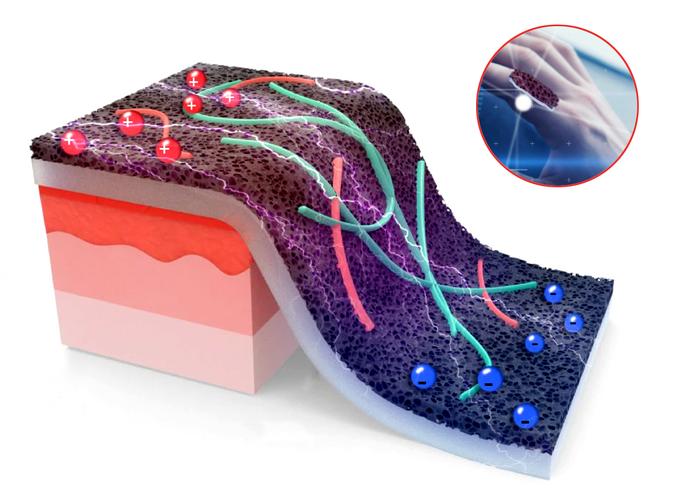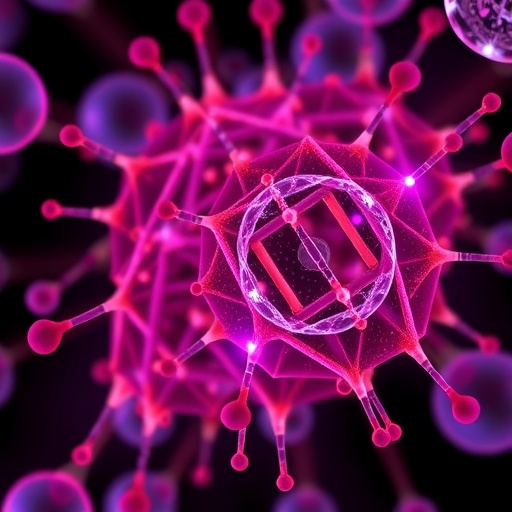In a groundbreaking development, researchers from Penn State University and China’s Hebei University of Technology have made significant strides in the field of wearable health monitoring technologies. At the core of their research is a new flexible sensor that utilizes laser-induced graphene to measure both temperature and physical strain. This sensor is particularly revolutionary due to its ability to distinguish between these two signals without interference—a challenge that has long plagued the realm of self-powered wearable sensors. By addressing this issue, the team aims to enhance the monitoring of wound healing, providing medical professionals with a far more accurate and nuanced understanding of the healing process.
The revelations surrounding this newly developed sensor material have far-reaching implications in health care monitoring. Huanyu “Larry” Cheng, an influential figure in the research and a professor at Penn State, emphasized the sensor’s potential applications in tracking various signals related to health conditions. According to Cheng, the ability to simultaneously and separately measure both temperature and strain could transform how medical professionals observe inflammation and recovery. This insight is especially pertinent given the myriad factors doctors must consider when evaluating wound healing.
The researchers harnessed the unique properties of laser-induced graphene, a material that exists in a two-dimensional format. Laser-induced graphene is formed when laser energy is applied to carbon-rich materials such as plastics or woods, effectively turning their surfaces into a graphene structure. This innovative technique allows for scalable production of graphene patterns for usage in a variety of devices, from sensors to energy storage systems, showcasing its versatility.
Cheng and his research team previously explored other applications for laser-induced graphene, leveraging it for technologies including gas sensors, electrochemical detectors, and supercapacitors. However, this study marks a pivotal moment in their exploration of the material’s characteristics. Cheng noted that the discovery of the material’s thermoelectric properties came almost serendipitously. This property enables the sensor to convert temperature differences into electrical voltage, a feature that is not merely advantageous but essential for the sensor’s operation.
The thermoelectric capabilities of laser-induced graphene present crucial advantages for applications requiring precise measurements with minimal interference. In the context of monitoring health metrics, the ability to decouple temperature and strain measurements means that medical personnel can rely on data that is not only accurate but distinct. This feature is invaluable when issues such as inflammation may manifest with overlapping symptoms, thereby complicating diagnosis and treatment.
The design of the sensor involves a porous structure that significantly enhances its sensitivity. The interconnected channels within the graphene allow for the effective interaction with its surrounding environment, making the sensor particularly well-suited for deployment in clinical settings. Furthermore, the material’s elasticity allows it to stretch up to 45 percent, making it adaptable to various shapes and surfaces without compromising its functionality, which is essential for integration into wearable devices.
A noteworthy aspect of this sensor is its self-powered capability. By taking advantage of its thermoelectric properties, the laser-induced graphene sensor can generate electrical energy when subjected to temperature differences. This feature allows for continuous monitoring without the need for external power sources, making it particularly advantageous for long-term usage in both clinical environments and everyday situations. The potential for such a self-sustaining system speaks volumes about the future of health monitoring, particularly in remote or underserved areas.
Additionally, the team is working on developing a wireless monitoring system that would facilitate real-time data access. This advancement aims to empower both health care providers and patients to track critical information concerning wounds and other health conditions from remote locations. Such technology could drastically reduce the need for frequent in-person appointments, enabling more efficient patient monitoring and timely interventions during critical phases of recovery.
Cheng further elaborated on the implications of this research, noting that it could pave the way for novel applications in diverse fields beyond healthcare. For instance, in emergency response scenarios, sensors equipped with this technology could detect temperature fluctuations indicative of fire hazards in remote areas. The versatility of laser-induced graphene is a testament to its potential impact across a range of applications, underscoring the need for continued research into its full capabilities.
Along with Cheng, the research paper lists several collaborators from both Penn State and Hebei University of Technology, highlighting a blend of expertise. Their collective efforts have culminated in a study poised to influence multiple sectors, particularly the ever-evolving landscape of medical technology. The potential for improved health outcomes through innovative monitoring strategies cannot be overstated, especially as health care moves toward more personalized and data-driven approaches.
The work has garnered support from renowned institutions, including the National Institutes of Health and the U.S. National Science Foundation. Such backing underscores the significance of the research and its potential contributions to public health initiatives. With an increasing focus on integrating technology into healthcare, findings like those presented in this study offer a glimpse into a future where wearable sensors become central to patient care and monitoring.
In conclusion, the new flexible sensor developed by the researchers stands at the intersection of technology and health care. With its ability to provide distinct and accurate measurements of both temperature and strain, this innovation offers profound implications for improving monitoring practices in wound care and beyond. As the fields of engineering and medicine continue to converge, the contributions of materials science like laser-induced graphene will undoubtedly play a pivotal role in shaping the future of health technology.
—
Subject of Research: Health Monitoring through Flexible Sensors
Article Title: Thermoelectric porous laser-induced graphene-based strain-temperature decoupling and self-powered sensing
News Publication Date: 17-Jan-2025
Web References: https://doi.org/10.1038/s41467-024-55790-x
References: N/A
Image Credits: Jennifer M. McCann/Penn State
Keywords: Wearable Sensors, Health Monitoring, Laser-Induced Graphene, Thermoelectric Properties, Wound Healing, Self-Powered Technology, Medical Applications, Flexible Electronics, Real-Time Monitoring.
Tags: accurate wound assessment toolsflexible smart sensor technologyhealthcare technology developmentsHebei University of Technology collaborationinflammation tracking in woundslaser-induced graphene applicationsmedical monitoring innovationsPenn State University researchself-powered wearable sensorstemperature and strain measurementwearable health monitoringwound healing advancements





